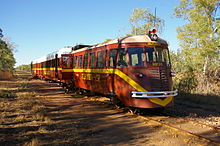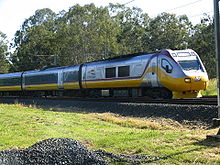- Queensland Rail
-
Queensland Rail Type government-owned corporation Industry Rail transport Founded 1865 Headquarters Brisbane, Australia Key people John Prescott AC, Chairman
Paul Scurrah, CEOServices railway network access, freight, logistics, commuter, long-distance Revenue  A$3.97 billion (08/09)[1]
A$3.97 billion (08/09)[1]Operating income  A$724 million (08/09)[1]
A$724 million (08/09)[1]Profit  A$298 million (08/09)[1]
A$298 million (08/09)[1]Employees 15,852[1] Website www.queenslandrail.com.au Queensland Rail, also known as QR, is a government-owned railway operator in the state of Queensland. Under the control of the Queensland Government, Queensland Rail operates the inner-city and long-distance passenger services, as well as some freight operations and gives railway access to other rail businesses.
Contents
Founded
Queensland Rail started business in 1865[2] with the first service carrying school children and dignitaries on the first rail line in Queensland running from Ipswich to Grandchester.[3]
Services and rollingstock
City network
Main article: CitytrainQueensland Rail, in partnership with TransLink, provides Urban and Interurban rail and bus services throughout South East Queensland. These rail services operate on eleven rail lines including Beenleigh, Caboolture, Cleveland, Doomben, Exhibition, Ferny Grove, Gold Coast, Gympie North, Ipswich, Rosewood and Shorncliffe lines. Queensland Rail provides train serices on these lines with its rolling stock of electric railcars, which includes the Electric Multiple Units (EMU), the Suburban Multiple Units (SMU), the Interurban Multiple Units (IMU) and the InterCity Express (ICE).
Due to low patronage, lines such as the Pinkenba line have been closed and replaced by bus services known as a RailBus. During some times of the day trains on the Gympie North line and Doomben line are also replaced by the RailBus.
Queensland Rail aims to operate 99.75% of peak services and to have 93.77% of those services running no longer than four minutes late.[4]
See also: Railways in South East QueenslandLong range
One of the two diesel tilt trains running its route in Queensland.
Queensland Rail provides long range passenger rail services throughout Queensland. Its flagships are the electric and diesel Tilt Trains, servicing Brisbane to Rockhampton and Brisbane to Cairns respectively. Queensland Rail also operates diesel-locomotive-hauled services between Brisbane and Cairns as The Sunlander, Brisbane to Longreach as Spirit of the Outback, Townsville to Mount Isa as The Inlander and Brisbane to Charleville as The Westlander.
Traveltrain's annual patronage is approximately 969,000.[5] Whilst proportionately smaller than other regional rail services, relative to population, this is largely as Traveltrain caters to a touring market more so than other operators. In 2007–08, the subsidy for the Brisbane-Cairns route was $130 million, or $900 per passenger. In 2001–02 it was $270.[6][7]
 Railmotor 93 running as The Gulflander, stop at Golden Gate near Croydon
Railmotor 93 running as The Gulflander, stop at Golden Gate near Croydon
Queensland Rail runs tourist trains between Normanton and Croydon as The Gulflander, Cairns to Kuranda as the Kuranda Scenic Railway, and Cairns to Forsayth as The Savannahlander.
Current fleet
As of September 2011 the Queensland Rail fleet consists of the following trains:[8]
- Electric Multiple Units (EMU) - 87 in service (88 built)
- Suburban Multiple Units (SMU)
- 200 Series (SMU200) - 12 in service (12 built)
- 220 Series (SMU220) - 30 in service (30 built)
- 260 Series (SMU260) - 36 to be in service
- Interurban Multiple Units (IMU)
- 100 Series (IMU100) - 10 in service (10 built)
- 120 Series (IMU120) - 4 in service (4 built)
- 160 Series (IMU160) - 28 to be in service
- InterCity Express (ICE) - 8 in service (8 built)
Public float of QR National
Main article: Public float of QR NationalOn June 2, 2009 the Queensland Government announced the 'Renewing Queensland Plan', with Queensland Rail's commercial activities to be separated from the Government's core passenger service responsibilities, and formed into a new company called QR National Limited.[9][10] The new structure was announced by the State Government on December 2, 2009,[11] and was in place from July 1, 2010.[12]
See also
- Rail transport in Queensland
- The Sunlander
References
- ^ a b c d "QR Annual Report 2008/2009". http://www.corporate.qr.com.au/Images/QR%20Annual%20Report%2008%2009_tcm15-28510.pdf. Retrieved 26 March 2010.
- ^ "Our Journey". About Us. Queensland Rail. http://www.queenslandrail.com.au/AboutUs/Pages/OurJourney.aspx. Retrieved 1 July 2010.
- ^ Nolan, Rachel (1 July 2010). "Welcome to the new Queensland Rail" (Press release). Queensland Government. http://statements.cabinet.qld.gov.au/MMS/StatementDisplaySingle.aspx?id=70427.
- ^ "Peak On-Time Results". Queensland Rail. http://www.queenslandrail.com.au/RAILSERVICES/CITY/Pages/PeakOn-TimeResults.aspx. Retrieved 28 October 2011.
- ^ Queensland Rail (2006) (PDF). 2005/06 Queensland Rail Annual Report. http://www.corporate.qr.com.au/Images/QR%20Annual%20Report%202005_06_tcm15-14708.pdf.
- ^ Wardill, Steven (26 December 2008). "$130m subsidy for Brisbane-Cairns Traveltrain". The Courier-Mail. http://www.news.com.au/couriermail/story/0,23739,24844502-3102,00.html.
- ^ Patrick Lion (28 December 2008). "$900-a-ticket subsidy for tilt train to remain, says Anna Bligh". The Courier Mail. http://www.news.com.au/couriermail/story/0,23739,24850081-3102,00.html.
- ^ Queensland Rail Fleet
- ^ Calligeros, Marissa (2 June 2009). "Queensland asset sales to reap $15 billion". Brisbane Times. http://www.brisbanetimes.com.au/queensland/queensland-asset-sales-to-reap-15-billion-20090602-bthd.html.
- ^ "Queensland assets sale". Queensland Government. http://www.qld.gov.au/assetssale/. Retrieved 20 July 2010.
- ^ "QR chair and CEO welcome sale decision". Media Release. Queensland Rail. 8 December 2009. http://www.queenslandrail.com.au/AboutUs/MediaCentre/MediaReleases/Pages/QRChairandCEOWelcomeSale.aspx.
- ^ Korporaal, Glenda (15 April 2010). "Hockridge carrying the burden of Queensland Rail". The Australian. http://www.theaustralian.com.au/business/hockridge-carrying-the-burden-of-queensland-rail/story-e6frg8zx-1225853814671.
External links
Queensland Rail's city rail lines Northern Southern Inner city Queensland Rail's long distance, tourist and freight rail lines Central West • Maryborough • Mount Isa • North Coast • South Western • Southern • Tablelands • WesternCategories:- 3ft 6in gauge railways
- Railway companies of Australia
- Rail transport in Queensland
Wikimedia Foundation. 2010.


